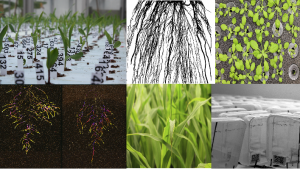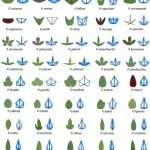How Green Became the New Black – Plant Phenotyping Developments Down Under

With the upcoming 5th International Plant Phenotyping Symposium (IPPS) set to take place Oct 2-5, in Adelaide, Australia, we look at how the plant phenotyping community has progressed over the last decade and how we can potentially address the issues surrounding data sharing, re-use, and reproducible research.
As we live in an increasingly data-driven era, the genomics community has, in particular, a long history of sharing data to drive this. Comparatively and for (mostly) technical reasons, phenotyping has had a comparative lack of data sharing infrastructure and practice. For the plant phenotyping community, there is an increasing need for original high-resolution scans to be accessible to others. Furthermore, heterogeneous datasets of multiple giga-terabytes scale are increasingly too large to include in traditional supplemental data, and repositories for high-resolution scans are often too specialized to take or will not accept such large datasets. There has also been a lack of incentives and credit to put in the effort to share these datasets. GigaScience author, Dan Chitwood, also highlights such issues in an author Q&A.
Although improvements in plant phenomics research have created many new opportunities to understand and predict dynamic phenotypic responses to genotypic variation; problems and opportunities have emerged – including the ability to collect phenotypic data in a way that can be combined with different datasets for meta-analyses, and the generation of models or ground-truth datasets. With plant sequencing projects getting to the scale of the Rice 3K project (3,000 Rice genomes) – there is now a need for high-throughput plant phenotyping data in these specific research communities to keep pace.
Plant phenotyping under the gum trees

The 5th International Plant Phenotyping Symposium (IPPS) is set to take place on Oct 2-5 in Adelaide, Australia. And since the inaugural IPPS back in 2009 in Canberra, a lot has happened in the area of plant phenotyping. Initially, there was a small number of early adopters back in 2009, discussing hardware developments that would allow measuring of thousands of plants. Fast forward to 2018, and the international community has grown considerably with many research groups getting on board. And now, the focus is no longer just about data acquisition but has shifted to data analysis, data management, and sharing. Importantly, one of the big questions is how to use the huge amounts of data for decision making in plant research and agriculture.
The 5th IPPS will bring together the international community to discuss the important aspects of how to move from the biological question to high-quality data and meaningful outcomes: “From Plant to Data to Impact”. In addition to the conference, the meeting in Adelaide offers different Working Groups of the International Plant Phenotyping Network, and the opportunity to exchange ideas in workshops and satellite meetings. If you’re planning on attending – be sure to take advantage of early bird registration which ends on August 6.
Those who can’t get enough of phenotyping and the Southern Hemisphere can also join a satellite workshop on Tree Phenotyping in New Zealand following on from IPPS. This is an interesting new area in phenotyping, as with recent advances in remote sensing it is now possible to collect phenotypic data for trees, relieving the bottleneck that has been associated with forestry.
GigaScience helps fill the data gaps
 GigaScience also has an open thematic series “Plant Phenomics – Data Integration and Analyses”, Guest Edited by Rubén Rellán Álvarez, Guillaume Lobet, Malia Gehan, Srikant Srinivasan. So far, a few highlights from our series includes, a unique morphometric dataset of passiflora leaves, machine learning algorithms to accelerate large-scale genetic studies, to a large-scale phenomics analysis of a T-DNA tagged mutant population – utilizing data from the Rice 3K Project that we published as a Data Note in 2014. Four years on, the utility of our incentivizing early data release with these Data Note articles can be seen with the resulting Research article finally being published in Nature a few months ago.
GigaScience also has an open thematic series “Plant Phenomics – Data Integration and Analyses”, Guest Edited by Rubén Rellán Álvarez, Guillaume Lobet, Malia Gehan, Srikant Srinivasan. So far, a few highlights from our series includes, a unique morphometric dataset of passiflora leaves, machine learning algorithms to accelerate large-scale genetic studies, to a large-scale phenomics analysis of a T-DNA tagged mutant population – utilizing data from the Rice 3K Project that we published as a Data Note in 2014. Four years on, the utility of our incentivizing early data release with these Data Note articles can be seen with the resulting Research article finally being published in Nature a few months ago.
We continue to encourage the submission of Research Articles and Technical Notes, as well as more Data Notes, which are perfect for focussing on the description of interesting plant phenomic datasets, curated and hosted in our database, GigaDB. We also consider Commentaries and thought-provoking Reviews in this area, so feel free to suggest topics and ideas to us.
 Potential topics covered by the series include, but are not limited to:
Potential topics covered by the series include, but are not limited to:
- New methods in phenotype data collection e.g. Drones, imaging techniques
- New tools in phenotype data integration and analyses
- Morphometrics
- Organ-scale phenomics
- Databases, management and workflows
- Research or Data wrapped in a virtualized or containerized form e.g. Docker, Singularity, etc.
You can submit your manuscript using GigaScience’s online submission system. Please, state clearly in your covering letter that it is intended for the Plant Phenomics thematic series. For further questions, please contact us at editorial@gigasciencejournal.com.
Our Editor down under, Nicole, will be at the 5th IPPS in Adelaide, and is happy to chat more with people there about our thematic series and GigaScience’s efforts to disseminate large-scale plant phenotyping data for re-use and to improve reproducibility of plant phenotyping research. Be sure to reach out to her via email (nicole@gigasciencejournal.com) or Twitter (@Medi_Cole).